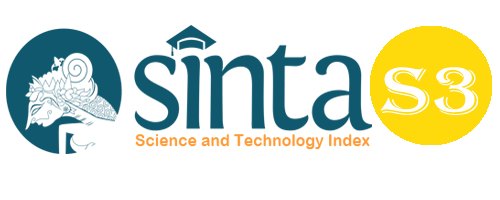Implementation of Employee Mapping in the Regional Apparatus of the Buleleng Regency Government
Abstract
In the structure of regional apparatus, there are individuals who play an important role in achieving organizational goals who fill critical position formations in the organization, but sometimes not all critical position formations in regional apparatus are filled which have an impact on the implementation of the duties and functions of regional apparatus. Employee mapping as one of the stages in talent management also contributes to the achievement of talent management goals. This study aims to analyze the implementation of employee mapping, identify obstacles in the implementation of employee mapping, and formulate strategies for implementing employee mapping in relation to employee career development in regional apparatus within the Buleleng Regency Government. This type of research is descriptive qualitative research, data collection is carried out by semi-structured interviews with selected (purposive) informants in regional apparatus whose critical position formations are not fully filled, field observations and secondary data collection from documents related to staffing in regional apparatus. Data analysis was carried out using the Miles and Huberman data reduction method. The research formulates a strategy for implementing employee mapping which consists of providing regional regulations governing the implementation of talent management, providing facilities for competency testing and employee assessment, as well as optimizing the personnel information system.
Keywords
Full Text:
PDFReferences
Awasthi, S., & Sharma, R. C. (2016). Employee Development through Competency Mapping: A way ahead for Organizational Growth. International Journal in Management & Social Science, 4(6), 260–270.
Diniati, I., Komariah, A., & Kurniady, D. A. (2018). Implementasi Talent Management Dan Motivasi Kerja Implikasinya Pada Kinerja Pegawai Direktorat. Jurnal Administrasi Pendidikan, 25(2), 294–306. https://doi.org/10.17509/jap.v25i2.15643
Endratno, H. (2017). Talent management Dalam Meningkatkan Kinerja Organisasi. The Nonprofit Human Resource Management Handbook: From Theory to Practice, 122–141. https://doi.org/10.4324/9781315181585
Irfan, M. (2020). Mewujudkan Sistem Perencanaan Suksesi Nasional Melalui Pembangunan Manajemen Talenta di Lingkungan Instansi Pemerintah. Civil Service, 14(Juni), 55–68.
Isa, A., Ibrahim, H. I., Jaaffar, A. H., & Baharin, N. L. (2018). Talent management practices, perceived organizational support and employee retention: Evidence from Malaysian government-linked companies. Global Business and Management Research, 10(3), 688–696. http://search.proquest.com.ezaccess.library.uitm.edu.my/docview/2159620684?accountid=42518
Klett, F., & Wang, M. (2013). Editorial: The war for talent: Technologies and solutions toward competency and skills development and talent identification. Knowledge Management and E-Learning, 5(1), 1–9. https://doi.org/10.34105/j.kmel.2013.05.001
Krissetyanti, E. P. L. (2013). Penerapan Strategi Manajemen Talenta Dalam Pengembangan PNS. Jurnal Kebijakan Dan Manajemen PNS, 7(1), 1–15.
Nagesh, P., Kulenur, S., & Jagadeesh, K. (2017). Employee Competency Mapping. SDMIMD Journal of Management, 8(2), 1–5. https://doi.org/10.18311/sdmimd/2017/18058
Niati, D. R., Siregar, Z. M. E., & Prayoga, Y. (2021). The Effect of Training on Work Performance and Career Development: The Role of Motivation as Intervening Variable. Budapest International Research and Critics Institute (BIRCI-Journal): Humanities and Social Sciences, 4(2), 2385–2393. https://doi.org/10.33258/birci.v4i2.1940
Novianto, M. H., & Artiawati. (2019). Strategi Identifikasi Dan Pemetaan Talenta Pada Branch Manager Sebagai Bagian Dari Sistem Manajemen Talenta. Jurnal Psikologi Sains Dan Profesi (Journal Psychology of Science and Profession), 3(1), 21–30.
Purwoko, A. P. (2018). Perencanaan Suksesi Dan Sistem Informasi Aparatur Sipil Negara. Civil Apparatus Policy Brief, 017, 1–4.
Shah, M. M., et al. (2020). The Development Impact of PT. Medco E & P Malaka on Economic Aspects in East Aceh Regency. Budapest International Research and Critics Institute-Journal (BIRCI-Journal) Volume 3, No 1, Page: 276-286.
Suryanto. (2019). Konsep Manajemen Talenta Di Sektor Publik : Studi Kasus Penerapan Manajemen Talenta Di Kementerian Keuangan dan Pemerintah Provinsi Jawa Tengah. Civil Service Journal, 13(2), 63–72
Werdhiastutie, A. et al. (2020). Achievement Motivation as Antecedents of Quality Improvement of Organizational Human Resources. Budapest International Research and Critics Institute-Journal (BIRCI-Journal) Volume 3, No 2, Page: 747-752.
DOI: https://doi.org/10.33258/birci.v5i3.5848
Article Metrics
Abstract view : 32 timesPDF - 25 times
Refbacks
- There are currently no refbacks.

This work is licensed under a Creative Commons Attribution-ShareAlike 4.0 International License.

This work is licensed under a Creative Commons Attribution-ShareAlike 4.0 International License.

_.gif)

















_.gif)



